How to Use Breast Milk Storage Bags
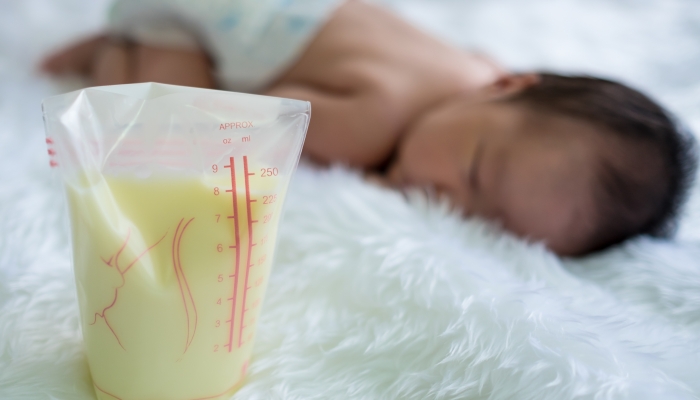
- Breast milk storage bags are essential for mothers who are returning to work or having difficulties with direct breastfeeding and want to continue their breastfeeding journey.
- Breast milk bags are designed to store and transport breast milk safely and conveniently.
- It’s best to store breast milk in smaller quantities.
- You can store breast milk in a breast milk storage bag on the countertop, refrigerator, and deep freezer.
- Breast milk can be safely thawed and reheated for feeding by following recommended guidelines.
I dreaded returning to work when our newborn was four months old. Besides leaving her at a daycare, I was worried about our breastfeeding journey. Pumping milk and figuring out how to use breast milk storage bags was overwhelming.
There’s a lot of conflicting advice about safe breastmilk storage. I wasn’t sure who was right and had no family members who breastfed to turn to for guidance. Luckily, I came across expert-led groups and websites for help.
This article was inspired by how defeated I felt. Below you’ll find everything you need to know about how to safely use breast milk storage bags to continue your breastfeeding journey, whether you need to return to work, want to arrange a date night, or have trouble with direct breastfeeding.
Advantages of Using Breast Milk Storage Bags
Breast milk storage bags are food-grade plastic bags designed to store fresh breast milk. They are sterile and made to seal tightly to prevent contamination. Like animal milk, human milk is highly susceptible to bacterial growth. Breast milk bags are the safest and most convenient way to store and transport this liquid gold for your baby.
Breast Milk Storage Bags Ensure Continued Breastfeeding
You can use breast milk storage bags when you return to work, want to build a milk stash for emergencies, or have other obligations preventing you from feeding your baby on demand.
Many breastfeeding women have inverted nipples, a forceful letdown, or breast engorgement that can make direct feeding difficult. If your little one has a tongue or lip tie, it could also cause trouble. Breast milk storage bags ensure a safe way to store milk for bottle feeding.
Breast Milk Storage Bags Are Easy and Convenient To Use
Breast milk storage bags have features that make them convenient to use. They are lightweight, leak-proof, and compact. Many have a strengthened bottom, making them self-standing in a freezer. Some also have pour spouts and a place to label the date and time you expressed the milk.
Breast Milk Storage Bags Are Safe to Use
Breast milk bags are made from food-grade BPA-free materials, making them safe for breast milk storage. You don’t have to worry about contamination or harmful chemicals seeping into the milk.
Reputable breast milk storage bag brands pre-sterilize the bags, ensuring they’re ready to use right out of the box. If you choose these, you won’t have to sterilize bags, saving you time and effort. This also ensures the bags are bacteria-free.
How Much Breast Milk Should You Put in a Storage Bag?
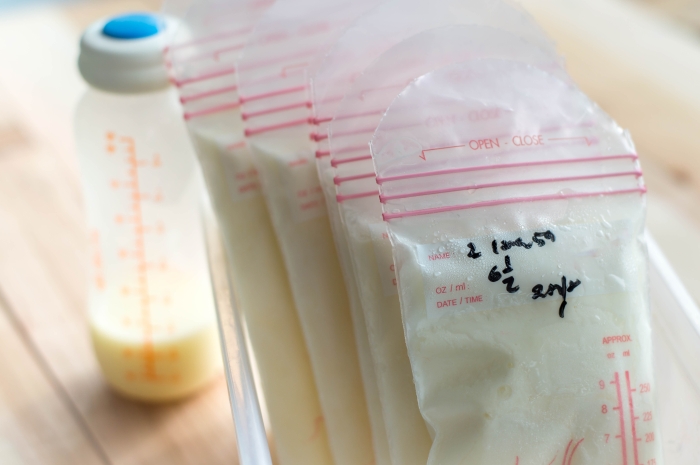
Breast milk storage bags typically hold 5 to 8 ounces of breast milk. You should check the bag guide and never overfill them. Overfilling your breast milk storage bags can cause them to leak or burst. Frozen breast milk expands, so you should leave enough room in the bag for expansion.
You should consider your baby’s feeding needs when deciding how much milk to store in each bag. Generally, it’s best to store your freshly pumped breast milk in smaller quantities. This helps prevent waste and makes it easier to thaw and use the milk later.
How to Use Breast Milk Storage Bags
Using breast milk storage bags doesn’t need to feel overwhelming. The process is straightforward. You only need to keep a few hygiene and storage points in mind. Here’s what you need to do:
- Write the date and time that you pumped the milk on the bag.
- Wash your hands thoroughly with soap and water before continuing.
- Open the bag and place it in a clean, dry container, like a bottle or a cup. This will help keep the bag stable and prevent it from spilling or tipping over.
- Use a funnel or adapter to pour the expressed milk directly into the bag without spilling.
- Let out excess air and seal the breast milk storage bag by pressing the zipper seal tightly to close it.
Breast Milk Storage Guidelines
Breast milk storage guidelines differ. Experts define room temperature differently, and your circumstances will also affect how you follow them. It’s always better to use milk sooner rather than later. Clearly indicating when you pumped the milk and using the first in-first out principle will help prevent spoilage.
The Centers for Disease Control and Prevention and the Academy of Breastfeeding Medicine provide the following fresh and frozen breast milk storage guidelines for healthy, full-term infants:
| Milk Type | Storage Location | Ideal Temperature | Time | Comment |
| Freshly Expressed | Countertop | 60° – 85°F (16° – 29°) | 4 hours | Breast milk should be covered and kept as cool as possible |
| Insulated Cooler Bag | 5° – 39°F (-15° – 4°) | 24 hours | Keep ice packs in constant contact with milk storage bags/containers. Limit opening the cooler bag. | |
| Refrigerator | +- 40°F (+-4°C) | 3 – 4 days | Store milk in the back of the main body of the refrigerator. | |
| Deep Freezer | 0°F (-18°C) or colder | 6 – 12 months | Store milk towards the back, away from the sides. | |
| Thawed, Previously Frozen | Countertop | 60° – 85°F (16° – 29°) | 1-2 hours | Place in a cool spot and keep covered. |
| Leftover from a feeding | Countertop | 60° – 85°F (16° – 29°) | 1-2 hours, then discard | Place in a cool spot and keep covered. |
Breastmilk Thawing and Reheating Guidelines
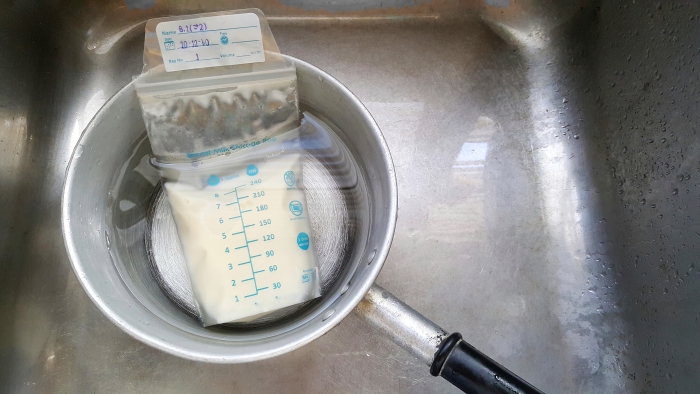
You can safely thaw and reheat breast milk for feeding. Follow these guidelines to ensure the milk stays safe and maintains its nutritional properties:
Thawing Breast Milk For Feeding
You should always thaw breast milk slowly to preserve its nutritional properties. The best way to thaw frozen breast milk is by placing the storage bag or container in the refrigerator for 12 – 24 hours. If you’re in a hurry, you can put the storage bag in a bowl of lukewarm water.
Tip: Place the milk storage bag in a sterilized container before adding it to the water bath. If the storage bag bursts or leaks, you won’t waste any milk!
You should never thaw breast milk in a microwave. This can cause hot spots that can damage antibodies.
Reheating Breast Milk For Feeding
It is safe to reheat refrigerated or thawed milk. To do it correctly, follow these guidelines on how many times you can reheat breast milk and how you should do this:
- Only reheat breast milk once. Reheating it multiple times could stimulate bacterial growth.
- Reheat fresh or thawed breast milk by placing the storage bag or bottle in a bowl of lukewarm water. You should let it sit for a few minutes.
- Never heat breast milk on the stove or in the microwave. This can overheat the milk and damage it.
Note: Once you’ve reheated milk, use it within 24 hours. Do not refreeze it. This can affect the milk’s quality and safety.
Is It Okay to Pump Directly Into a Breast Milk Storage Bag?
You can pump directly into a breast milk storage bag if its design is compatible with your breast pump. This can make pumping and storing breast milk more convenient and efficient. It will save you time and minimize the risk of spills.
Remember to label the breast milk bag before starting. You should also ensure it’s securely attached to your breast pump and properly positioned to avoid spills and leaks. If your breast pump isn’t compatible with your breast milk bags, you can try using an adapter that attaches to the storage bag.
How Many Breast Milk Storage Bags Do You Need?
The number of breast milk bags you need depends on several factors. These include:
- How much milk you produce
- Whether you’re combination feeding or expressing exclusively
- How much your baby feeds
A general guideline is to have at least 30 – 50 breast milk storage bags on hand. If you plan to pump and store milk regularly, you may need more to ensure you always have enough. It’s also a good idea to have extra bags in case of spills, leaks, or other issues.
How To Choose The Right Breast Milk Storage Bag
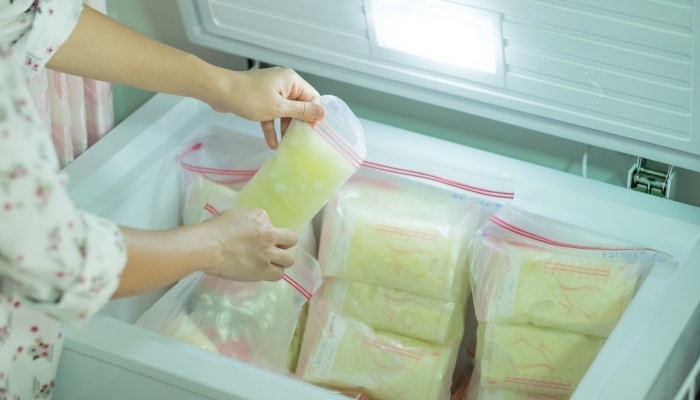
Credible breast milk storage bag brands typically tick all the right boxes. If you’re unsure which brand is best, choose a milk storage bag that is:
BPA-free: Look for storage bags that are BPA-free. Bisphenol A is a chemical used in the production of some plastics. It has been linked to potential health risks. It’s important to choose bags labeled as BPA-free to ensure no harmful chemical leach into your breastmilk.
Pre-sterilized: Choosing breastmilk storage bags that are pre-sterilized will save you time and effort. You should never store breast milk in containers that have not been sterilized properly. This could lead to bacterial growth.
Durable: Look for bags that are made from strong, durable plastic. Some bags have extra layers or thicker material to enhance their durability. If you plan to freeze the milk longer, choosing a stronger bag will help prevent bursts and leaks.
Easy to Use: Choose a storage bag that’s easy to use and store. You can look for bags with a double zipper, pour spout, and gusseted bottom.
Big or Small Enough: You should consider how much milk you plan to store. Breast milk storage bags are available in various sizes. If you’re following a strict pumping schedule, you might need bigger or more storage bags than you would when only storing the occasional extras. Ensure the bags you choose can hold the capacity you plan to store and are compatible with your freezer.
Affordable: If you plan on building a large stash of frozen milk, consider the cost of different bags. Keep quality in mind when shopping around. You’re sure to find storage bags in your budget without having to choose the cheapest options that compromise quality.
Don’t Cry Over Spilled Milk!
Any breastfeeding mother would agree that spilling breast milk is one of the worse things that could happen. Even worse is thawing frozen milk only to discover it’s gone bad. If you use incorrect storage methods or subpar bags, this could happen.
Handling and storing breast milk properly is essential to ensure its quality and safety. If you know how to use breast milk storage bags correctly, you can avoid crying over spilled milk and ensure your liquid gold stays fresh and nourishing for your baby.
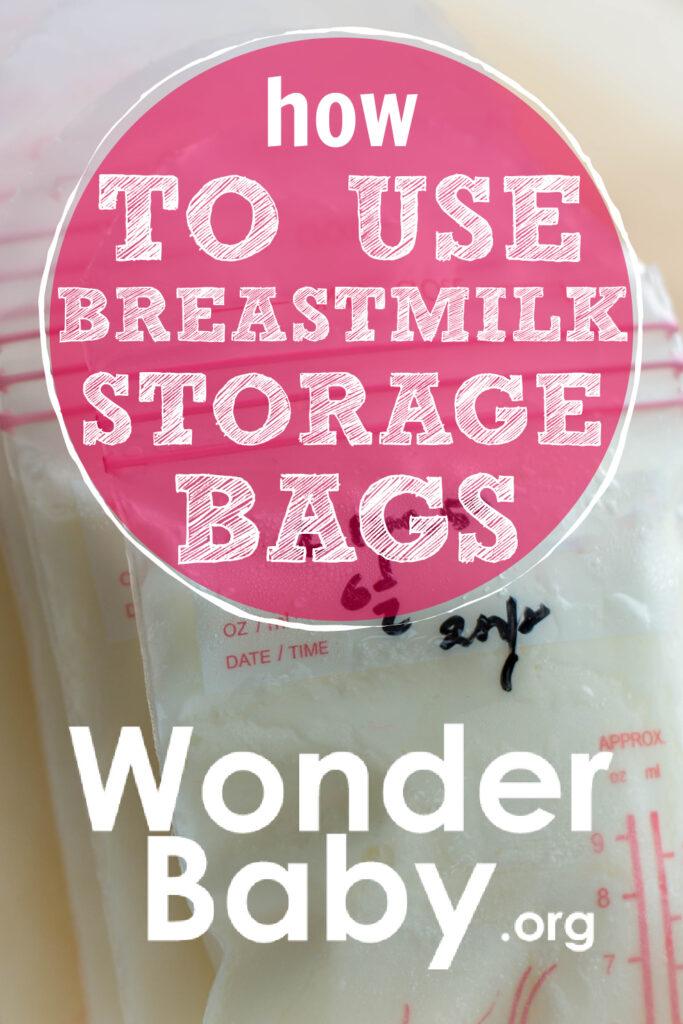
Related Posts

Breastfeeding, Sleep
Sleep and Breastfeeding: A Comprehensive Guide for Nursing Moms
Many people assume breastfeeding and sleep training don’t go together, but it is possible to help your baby sleep better while continuing your breastfeeding journey.

Breastfeeding
Comfort Nursing: Pros, Cons, and How to Stop
Find out what comfort nursing is, when should you worry about it, and how to stop or limit your baby's comfort nursing (especially at night!).

Breastfeeding, Product Reviews
5 Best Breastfeeding Chairs for Nursing Moms of 2023
Whether you want a gentle rock, a smooth glide, or a cozy cuddle to soothe your baby to sleep, you’ll have your pick of the best breastfeeding chairs on the...